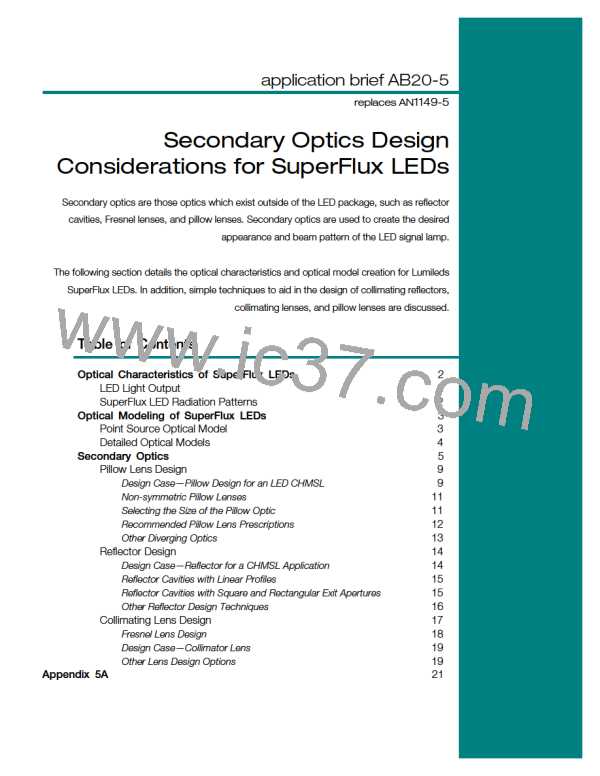Optical Characteristics of
SuperFlux LEDs
LED Light Output
The light output of an LED is typically described
by two photometric measurements, flux and
intensity.
Solid angle is used to describe the amount of
angular space subtended. Angular space is
described in terms of area on a sphere. If a solid
angle w, with its apex at the center of a sphere of
radius r, subtends an area A on the surface of
In simple terms, flux describes the rate at which
light energy is emitted from the LED. Total flux
from an LED is the sum of the flux radiated in all
directions. If the LED is placed at the center of a
sphere, the total flux can be described as the
sum of the light incident over the entire inside
surface of the sphere. The symbol for
2
that sphere, then w = A/r . The units for solid
angle are steradians (sr).
To put some of these concepts into perspective,
consider the simple example of a candle. A
candle has an intensity of approximately one
candela. A candle placed in the center of a
sphere radiates light in a fairly uniform manner
photometric for flux is F v, and the unit of
measurement is the lumen (lm).
2
2
2
over the entire inner surface (w = A/ r = 4p r / r =
4p steradians). With this information, the flux from
a candle can be calculated as shown below:
In simple terms, intensity describes the flux
density at a position in space. Intensity is the
flux per unit solid angle radiating from the LED
source. The symbol for photometric intensity is
Iv, and the unit of measurement is the candela
(cd).
SuperFlux LED Radiation Patterns
The radiation pattern of an LED describes
how the flux is distributed in space. This is
accomplished by defining the intensity of the
LED as a function of angle from the optical axis.
intensity, the radiation pattern becomes a
description of how the flux is distributed,
independent of the amount of flux produced.
Figure 5.1 shows a graph of the radiation pattern
for an HPWA-Mx00 LED.
Since the radiation pattern of most LEDs is
rotationally symmetric about the optical axis, it
can be described by a simple, two-axis graph of
intensity versus angle from the optical axis.
Intensity is normalized in order to describe the
relative intensity at any angle. By normalizing
An attribute of the radiation pattern that is of
common interest is known as the full-width, half-
max, or 2q1/2. This attribute describes the full
angular width of the radiation pattern at the half
power, or half maximum intensity point. Looking

 LUMILEDS [ LUMILEDS LIGHTING COMPANY ]
LUMILEDS [ LUMILEDS LIGHTING COMPANY ]